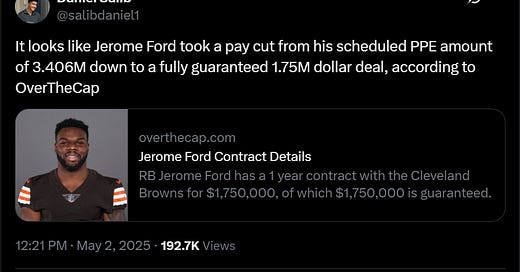Proven Performance Escalators and the Unintended Consequences of Good Intentions
Jared Sapp looks at how an effort to reward those who outplay their draft positions has been loopholed by teams across the NFL.
Immediately after April’s NFL Draft, Browns running back Jerome Ford was essentially forced into a pay cut, reducing his 2025 salary from $3.4 million to $1.75 million. Cleveland did guarantee the smaller amount, all but assuring Ford would round out their running back room with rookies Quinshon Judkins and Dylan Sampson.
There is an element of unfairness in Cleveland’s business decision. Ford played 1155 offensive snaps from 2023-24, totaling 1922 scrimmage yards and 11 all-purpose touchdowns. His efforts earned him a mandatory raise for the final season of his rookie contract under the league’s Proven Performance Escalator (PPE), although the additional money was not guaranteed.
Unfortunately for Ford, the combination of a moderately high non-guaranteed salary and a generationally deep draft class for his position endangered his roster spot. The Browns also waited until after the draft, when 90-man rosters become full and players have minimal leverage in seeking new teams, to approach him about the salary reduction.
A similar scenario played out earlier this week with Bengals guard Cordell Volson agreeing to a pay cut of over a million dollars. He played every offensive snap for Cincinnati in 2023 and started 48 of 51 games over his first three seasons.
This begs the question of how much the PPE truly benefits players.
Philosophy of PPE
In theory, the PPE is intended to refute the idea that it is sometimes better to be an undrafted free agent than day three draft pick. Because UDFAs sign three-year entry contracts, players greatly outperforming expectations qualify for restricted free agency after their third seasons, while their drafted brethren remain tied to a cheap rookie contract for a fourth season.
To remedy the discrepancy, the PPE mandates fourth-year raises for rookies selected outside of the first round in accordance with expected tenders to restricted free agents.
Over the Cap lists 40 players that are currently in line for the Level One raise that Ford and Volson lost out on. This is earned by playing at least 35% of a team’s offensive or defensive snaps in at least two of a player’s first three seasons (the snap count threshold is 60% for second round selections). These players earn a salary bump to about $3.4 million – the cost of a “right of first refusal” tender to a restricted free agent.
With base salary not actually payable until Week One of the regular season, expect more of these players to be approached about possible pay cuts.
Ten players are projected to get Level Two raises to about $3.7 million ($250,000 more than the Level One figure). Since these players saw at least 55% of the team’s offensive or defensive snaps in all of their first three seasons, their question is less of staying on the team than if they will sign extensions before the season starts.
The five players who have earned Level Three escalators (running backs James Cook and Kyren Williams, cornerbacks Tariq Woolen and DaRon Bland, and pass rusher Nik Bonito) are firmly on extension watch. These players have seen their final rookie contract salaries balloon to over $5.3 million – the cost of a second round restricted free agency tender. Because this level is earned by being named to at least one Pro Bowl (on the original ballot), this group likely has its eyes set on higher pay days. It will be surprising if any actually play on their PPE-augmented 2025 salaries, and this quintet should be watched for potential contract standoffs extending into training camp.
Could Other Level One Players Lose Out On The Raise?
Some players who have secured level one escalators, such as Buccaneers guard Luke Goedeke and Ravens tight end Isaiah Likely, are strong extension candidates as camp approaches. Other players will find as camp goes on that their teams do not value their service enough to pay more for it. More players will be forced to accept a steep pay cut (assuming they are not outperformed in camp by a cheaper option and cut outright).
It should also be remembered that even if a team nominally has salary cap space (and is willing to ride the offseason with the number on the books), front offices are more wary of paying actual dollars to backup players once the season starts.
Chiefs cornerback Joshua Williams qualifies for the raise mainly due to injuries increasing his playing time in 2022 and 2024. Once Kansas City’s secondary was healthy for last postseason, however, Williams did not see a defensive snap in any of the team’s three playoff games. It is unlikely the Chiefs will pay more than $3 million to a defender they prefer only sees special teams snaps.
Cowboys linebacker Damone Clark saw his defensive snaps plummet from 73% in 2023 to 15% in 2024. With a new defensive coaching staff in Dallas, Clark may have a high bar to clear to justify his boosted salary.
Vederian Lowe of the Patriots finished 2024 as PFF’s 101st ranked tackle. Assuming fourth overall selection Will Campbell has already taken Lowe’s job, it will be hard to justify paying a high salary for a backup who has disappointed when on the field.
An interesting case will be Packers wideout Romeo Doubs, who has had public conflicts with the team. While $3.4 million is not unreasonable given Doubs’ production from 2023-24, the team may be wary of paying an oft- malcontent player after drafting receivers in the first and third rounds. Doubs is unlikely to be cut outright, but he should be watched as a trade candidate as teams suffer injuries at the position in camp or preseason.
How To Improve The PPE System
The 2020 CBA created the PPE to reward players who outperform rookie contracts. Five years later, the program does not appear to work as planned. Increased fourth year salaries can speed up extension talks with players teams were already planning on signing to second contracts. Unfortunately, the mandatory raises can be a detriment to roster security of more marginal players.
Because the issue only affects a few dozen players per year, PPE raises are unlikely to become fully guaranteed in the next CBA. A reasonable compromise might be an opt out date where teams can fully vest the raise or allow the player to become a free agent after three seasons – similar to a non-tendered pending restricted free agent.
Marginal players would likely still frequently negotiate fully guaranteed reduced amounts, as we continually see with agreed to pay cuts. Mandating the decision earlier in the offseason, however, would somewhat even the power structure over the current reality, with teams consistently forcing bad decisions on players as league wide roster space shrinks after the draft (or even after August roster cuts).
Another feasible option would be to exempt PPE raises from the salary cap, similar to four-year qualifying funds teams can offer long time contributors on one-year contracts. This may not be a solution, however, as teams are often content carrying the salaries on the offseason salary cap before declining to pay the players actual dollars when the season starts.
Snap counts also simply might not be the best metric to decide on mandatory raises. Some players are qualifying for the PPE in the first place not because of irreplaceable talent but because injuries often force replacement-level players onto the field. Even top teams are sometimes willing to work around one or two weak links on offense or defense – as long as those snaps come at minimal cost.
Of course, getting the NFL’s 32 teams to agree to incentives metrics outside of box score scouting has a tall order. Traditional counting stats would not be a problem for evaluating wide receivers, running backs, and the occasional Brock Purdy level quarterback. Other positions would require advanced data to quantify, for example, why Goedeke merits a raise but Lowe doesn’t.
Ultimately, the decision on which players merit PPE raises will presumably continue resting with individual teams. While the NFLPA will be very backed up with issues to negotiate in the next CBA, they should push for a vesting date near the start of the league year for PPE raises. Some players would be unexpectedly cut. More would assuredly make the same decision to accept pay cuts in March that they currently do in May and throughout the summer. Transparency in the process, however, is needed. Careers are short, and if a player is not in a team’s plans, that decision should be made early enough to realistically find a better situation.





